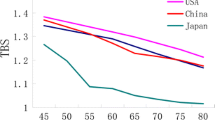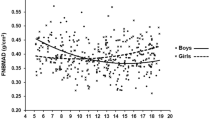Abstract
Summary
Childhood and adolescence are crucial periods for healthy bone development throughout life. This study aims to establish normative data for trabecular bone score (TBS) and bone mineral density (BMD) measurements using dual-energy X-ray absorptiometry (DXA) in healthy Brazilian children and adolescents.
Purpose
To establish normative data for trabecular bone score (TBS) and bone mineral density (BMD) measurements using dual energy X-ray absorptiometry (DXA) in healthy Brazilian children and adolescents.
Methods
Healthy children and adolescents, aged 5 to 19 years, underwent medical interview, physical examination with anthropometric measurement, pubertal stage evaluation, and bone densitometry by DXA (Hologic QDR 4500). Boys and girls were divided into 2 age groups: 5–9 years old (children) and 10–19 years old (adolescents). BMD and bone mineral content (BMC) were measured following standard procedures. TBS measurements were performed using the TBS Insight ® v3.0.3.0 software.
Results
A total of 349 volunteers were enrolled in this cross-sectional study. Reference values were defined for each group of children and adolescents divided into 3-year age groups. Girls had lower values of TBS compared to boys (1.356 ± 0.116 and 1.380 ± 0.086 respectively, p = 0.029). For both boys and girls, BMC and spine BMD measurements were significantly higher in adolescent than in children (p = 0.0001; p = 0.0001; p = 0.0001, p = 0.0001, respectively). TBS range increased as pubertal development progressed. In both girls and boys, a 1-year increase in age was associated to a 0.013 increase in TBS. Body mass was a significant determinant for TBS. In girls, a 1 kg/m2 increase in BMI was associated to an average TBS increase of 0.008.
Conclusion
Our findings reinforce the evidence that TBS varies according to age, sex, and pubertal stage in healthy children and adolescents. This study established reference values for TBS in healthy Brazilian children and adolescents which can be used as normative data for this population.

Similar content being viewed by others
References
Bailey DA, McKay HA, Mirwald RL, Crocker PRE, Faulkner RA (1999) A six-year longitudinal study of the relationship of physical activity to bone mineral accrual in growing children: the University of Saskatchewan bone mineral accrual study. J Bone Miner Res 14:1672–1679. https://doi.org/10.1359/jbmr.1999.14.10.1672
Heaney RP, Abrams S, Dawson-Hughes B, Looker A, Marcus R, Matkovic V et al (2000) Peak bone mass. Osteoporosis Int 11:985–1009. https://doi.org/10.1007/s001980070020
Mora S, Gilsanz V (2003) Establishment of peak bone mass. Endocrinol Metab Clin N Am 32:39–63. https://doi.org/10.1016/S0889-8529(02)00058-0
Kalkwarf HJ, Abrams SA, DiMeglio LA, Koo WWK, Specker BL, Weiler H (2014) Bone densitometry in infants and young children: the 2013 ISCD pediatric official positions. J Clin Densitom 17(2):243–57. https://doi.org/10.1016/j.jocd.2014.01.002
Hans D, Barthe N, Boutroy S, Pothuaud L, Winzenrieth R, Krieg MA (2011) Correlations between trabecular bone score, measured using anteroposterior dual-energy X-ray absorptiometry acquisition, and 3-dimentional parameters of bone microarchitecture: an experimental study on human cadaver vertebrae. J Clin Densitom 14(3):302–311. https://doi.org/10.1016/j.jocd.2011.05.005
Hans D, Goertzen AL, Krieg MA, Leslie WD (2011) Bone microarchitecture assessed by TBS predicts osteoporotic fractures independent of bone density: the Manitoba study. J Bone Miner Res 26(11):2762–2769. https://doi.org/10.1002/jbmr.499
Donaldson AA, Feldman HA, O’Donnell JM, Gopalakrishnan G, Gordon CM (2015) Spinal bone texture assessed by trabecular bone score in adolescent girls with anorexia nervosa. J Clin Endocrinol Metab 100(9):3436–3442. https://doi.org/10.1210/jc.2015-2002
Rehberg M, Azim M, Martakis K, Winzenrieth R, Hoyer-Kuhn H, Schoenau E et al (2020) Bone microarchitecture assessed by trabecular bone score is independent of mobility level or height in pediatric patients with cerebral palsy. J Bone Miner Res 35(9):1685–1694. https://doi.org/10.1002/jbmr.4047
Levy-Shraga Y, Megnazi O, Modan-Moses D, Tripto-Shkolnik L, Gruber N, Haberman Y et al (2021) Trabecular bone score in children and adolescents with inflammatory bowel diseases. J Clin Densitom 24(2):243–251. https://doi.org/10.1016/j.jocd.2020.10.008
Rodari G, Scuvera G, Ulivieri FM, Profka E, Menni F, Saletti V et al (2018) Progressive bone impairment with age and pubertal development in neurofibromatosis type I. Arch Osteoporos 13(1):93. https://doi.org/10.1007/s11657-018-0507-8
Wagh A, Ekbote V, Khadilkar V, Khadilkar A (2021) Trabecular bone score has poor association with pQCT derived trabecular bone density in Indian children with type 1 diabetes and healthy controls. J Clin Densitom 24(2):268–274. https://doi.org/10.1016/j.jocd.2020.12.001
Dowthwaite JN, Winzenrieth R, Binkley N, Krueger D, Scerpella TA (2017) A focused evaluation of lumbar spine trabecular bone score in the first-year post-menarche. Arch Osteoporos 12(1):90. https://doi.org/10.1007/s11657-017-0388-2
Guagnelli MA, Winzenrieth R, Lopez-Gonzalez D, McClung MR, Del Rio L, Clark P (2019) Bone age as a correction factor for the analysis of trabecular bone score (TBS) in children. Arch Osteoporos 14(1):26. https://doi.org/10.1007/s11657-019-0573-6
Shawwa K, Arabi A, Nabulsi M, Maalouf J, Salamoun M, Choucair M et al (2016) Predictors of trabecular bone score in school children. Osteoporos Int 27(2):703–710. https://doi.org/10.1007/s00198-015-3255-2
WHO: Multicentre Growth Reference Study Group (2006) WHO child growth standards: length/height-for-age, weight-for-age, weight-for-length, weight-for-height, and body mass index-for-age: methods and development. Geneva WHO. https://apps.who.int/iris/handle/10665/43413
Matsudo S, Araújo T, Matsudo V, Andrade D, Andrade E, Oliveira LC, Braggion G (2012) Questionário internacional de atividade física (IPAQ): estudo de validade e reprodutibilidade no Brasil. Revista Brasileira De Atividade Física & Saúde 6(2):5–18. https://doi.org/10.12820/rbafs.v.6n2p5-18
Tanner JM (1962) Growth at adolescence, 2nd edn. Blackwell scientific publications, Oxford
Rasmussen AR, Wohlfahrt-Veje C, de Renzy-Mzrtin KT, Hagen CP, Tinggaard J, Mouritsen A et al (2015) Pediatrics 135(1):86–93. https://doi.org/10.1542/peds.2014-0793
WHO Study Group on Young People and ‘Health for All by the Year 2000’ & World Health Organization (1986) Young people’s health - a challenge for society : report of a WHO Study Group on Young People and “Health for All by the Year 2000” [meeting held in Geneva from 4 to 8 June 1984]. World Health Organization. https://apps.who.int/iris/handle/10665/41720
Crabtree NJ, Arabi A, Bachrach LK, Fewtrell M, El-Hajj Fuleihan G, Kecskemethy HH et al (2014) International Society for Clinical Densitometry. Dual-energy X-ray absorptiometry interpretation and reporting in children and adolescents: the revised 2013 ISCD pediatric official positions. J Clin Densitom 17(2):225–42. https://doi.org/10.1016/j.jocd.2014.01.003
Gordon CM, Leonard MB, Zemel B (2014) International Society for Clinical Densitometry. 2013 Pediatric position development conference: executive summary and reflections. J Clin Densitom 17(2):219–24. https://doi.org/10.1016/j.jocd.2014.01.007
Kelly TL, Wilson KE, Heymsfield SB (2009) Dual energy x-ray absorptiometry body composition reference values from NHANES. PLoS One 4:7038–7045. https://doi.org/10.1371/journal.pone.0007038
Weber DR, Leonard MB, Zemel BS (2012) Body composition analysis in the pediatric population. Pediatr Endocrinol Rev 10(1):130–139
Guo B, Wu Q, Gong J, Xiao Z, Tang Y, Shang J et al (2016) Gender difference in body fat for healthy Chinese children and adolescents. Child Obes 12(2):144–154. https://doi.org/10.1089/chi.2015.0139
Marwaha RK, Garg MK, Bhadra K, Mahalle N, Mithal A, Tandon N (2017) Lean body mass and bone health in urban adolescents from northern India. Indian Pediatr 54(3):193–198. https://doi.org/10.1007/s13312-017-1029-y
Ripka WL, Orsso CE, Haqq AM, Luz TG, Prado CM, Ulbricht L (2020) Lean mass reference curves in adolescents using dual-energy x-ray absorptiometry (DXA). PLoS One 15(2):e0228646. https://doi.org/10.1371/journal.pone.0228646
Guagnelli MA, Winzenrieth R, Lopez-Gonzalez D, McClung MR, del Rio L, Clark P (2019) Bone age as a correction factor for the analysis of trabecular bone score (TBS) in children. Arch Osteoporosis 14:26. https://doi.org/10.1007/s11657-019-0573-6
Kalkwarf HJ, Sheperd JA, Hans D, Rodrigues EG, Kindler JM, Lappe JM et al (2022) Trabecular bone score reference values for children and adolescents according to age, sex, and ancestry. J Bone Miner Res 37(4):776–785. https://doi.org/10.1002/jbmr.4520
Silva BC, Walker MD, Abraham A, Boutroy S, Zhang C, McMahon DJ et al (2013) Trabecular bone score is associated with volumetric bone density and microarchitecture as assessed by central QCT and HRpQCT in Chinese American and white women. J Clin Densitom 16(4):554–561. https://doi.org/10.1016/j.jocd.2013.07.001
Joeris A, Lutz N, Wicki B, Slongo T, Audigé L (2014) An epidemiological evaluation of pediatric long bone fractures- a retrospective cohort study of 2716 patients from two Swiss tertiary pediatric hospitals. Pediatrics 14:314. https://doi.org/10.1186/s12887-014-0314-3
Martin RH, Uezu R, Parra AS, Arena SS, Bojikian LP, Bohme MT (2001) Auto-avaliação da maturação sexual masculina por meio da utilização de desenhos e fotos (Self-assessment of male sexual maturation through the use of drawings and photos.). Rev Paul Educ Fis 15:212–22. https://doi.org/10.11606/issn.2594-5904.rpef.2001.139903
Bojikian LP, Massa M, Martin RHC, Teixeira, CP, Kiss MAPD, Böhme MTS (2012) Auto-avaliação puberal feminina por meio de desenhos e fotos. Rev Bras Ativ Fis Saude 7(2):24–34. https://doi.org/10.12820/rbafs.v.7n2p24-34
Funding
This work was supported by the Remaining Funds of the Brazilian Society of Rheumatology.
Author information
Authors and Affiliations
Corresponding author
Ethics declarations
Conflicts of interest
None.
Additional information
Publisher's note
Springer Nature remains neutral with regard to jurisdictional claims in published maps and institutional affiliations.
Learning objectives
On completion of this article, you should be able to:
1. Have gathered normative data of trabecular bone score to compare with other children and adolescents.
2. Have gathered normative data of bone mineral density to compare with other children and adolescents.
3. Understand that Trabecular bone score (TBS) and bone mineral density (BMD) can vary according to sex, age, and pubertal stage.
Rights and permissions
Springer Nature or its licensor (e.g. a society or other partner) holds exclusive rights to this article under a publishing agreement with the author(s) or other rightsholder(s); author self-archiving of the accepted manuscript version of this article is solely governed by the terms of such publishing agreement and applicable law.
About this article
Cite this article
Fraga, M.M., de Sousa, F.P., Szejnfeld, V.L. et al. Trabecular bone score (TBS) and bone mineral density (BMD) analysis by dual X‐ray absorptiometry (DXA) in healthy Brazilian children and adolescents: normative data. Arch Osteoporos 18, 82 (2023). https://doi.org/10.1007/s11657-023-01291-1
Received:
Accepted:
Published:
DOI: https://doi.org/10.1007/s11657-023-01291-1




